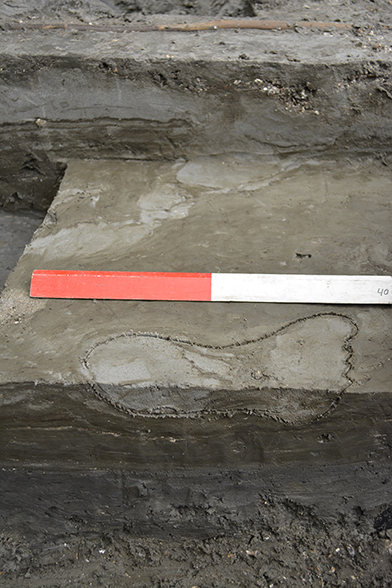 |
| 4/4. Prehistoric footprints (image Museum Lolland-Falster) |
Exciting news from Denmark: archaeologists working on the Fehmarn Belt Tunnel scheme, have uncovered evidence for 5,000-year-old human footprints (source Museum Lolland-Falster). The footprints were identified along the edge of an ancient post-and-wattle fish-trap, which was built in an area of coastline that had formerly been occupied by a series of inlets and rivers.
At least two sets of footprints were found and it appears that they were left by people who had been repairing the fish-trap after a storm. Terje Stafseth, an archaeologist working with the Museum Lolland-Falster, believes these may be the first Stone Age footprints identified in Denmark. irisharchaeology.ie
Link 2: Archaeologists unearth 5,000-year-old footprints - The Copenhagen Post
Archaeologists working on the excavations for the
Femern Bælt Tunnel have discovered several well-preserved footprints
dating back to the Stone Age.
"It is quite surreal to have found human footprints," said archaeologist Terje Stafseth in a press release.
"We normally find historical clues in the form of human waste, but here we have found an entirely different clue and a first in Danish archaeology: a physical print left behind by a human."...
Vídeo YouTube por jacobtjohansen el 7/11/2014 añadido a Paleo Vídeos > Prehistoria Universal > L.R.2.7 nº 32.
Actualización 12-11-14: Antiguas huellas humanas emergen en aguas danesas – RT
Las huellas de pisadas fueron halladas en el sur de Dinamarca, durante unos trabajos de construcción y pertenecerían al menos a dos personas que vivieron durante la Edad de Piedra, informa 'Daily Mail'.
"Es algo surrealista, porque normalmente encontramos indicios históricos en forma de residuos humanos, pero aquí hemos encontrado algo totalmente diferente y un hito en la arqueología danesa: una huella física dejada por un ser humano", dijo Terje Stafseth, uno de los responsables del hallazgo.
Las pisadas se encontraron en los restos de una antigua presa usada para la pesca, por lo que expertos del Museo Lolland-Faster consideran que las huellas fueron hechas por los pescadores locales mientras intentaban reforzar las barreras de la presa durante una tormenta.
Según los investigadores, la fuerza de la tormenta hizo que las barreras de la construcción cedieran, cayendo sobre la placa de arena donde quedaron impresas las huellas. Con el peso la placa se sumergió en el agua y más tarde la arena se endureció, ayudando a que las marcas se conservaran en perfecto estado.







1 comentario:
Actualización: Antiguas huellas humanas emergen en aguas danesas – RT
Publicar un comentario